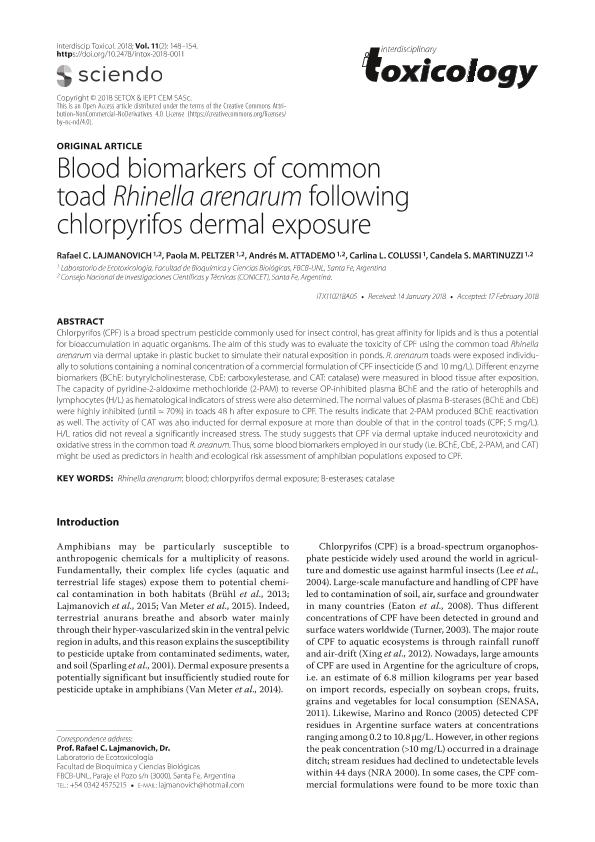Artículo
Blood biomarkers of common toad Rhinella arenarum following chlorpyrifos dermal exposure
Lajmanovich, Rafael Carlos ; Peltzer, Paola Mariela; Attademo, Andres Maximiliano
; Peltzer, Paola Mariela; Attademo, Andres Maximiliano ; Colussi, Carlina Leila; Martinuzzi, Candela Soledad
; Colussi, Carlina Leila; Martinuzzi, Candela Soledad
 ; Peltzer, Paola Mariela; Attademo, Andres Maximiliano
; Peltzer, Paola Mariela; Attademo, Andres Maximiliano ; Colussi, Carlina Leila; Martinuzzi, Candela Soledad
; Colussi, Carlina Leila; Martinuzzi, Candela Soledad
Fecha de publicación:
03/2018
Editorial:
Sciendo
Revista:
Interdisciplinary Toxicology
ISSN:
1337-9569
Idioma:
Inglés
Tipo de recurso:
Artículo publicado
Clasificación temática:
Resumen
Chlorpyrifos (CPF) is a broad spectrum pesticide commonly used for insect control, has great affinity for lipids and is thus a potential for bioaccumulation in aquatic organisms. The aim of this study was to evaluate the toxicity of CPF using the common toad Rhinella arenarum via dermal uptake in plastic bucket to simulate their natural exposition in ponds. R. arenarum toads were exposed individually to solutions containing a nominal concentration of a commercial formulation of CPF insecticide (5 and 10 mg/L). Different enzyme biomarkers (BChE: butyrylcholinesterase, CbE: carboxylesterase, and CAT: catalase) were measured in blood tissue after exposition. The capacity of pyridine-2-aldoxime methochloride (2-PAM) to reverse OP-inhibited plasma BChE and the ratio of heterophils and lymphocytes (H/L) as hematological indicators of stress were also determined. The normal values of plasma B-sterases (BChE and CbE) were highly inhibited (until ≈ 70%) in toads 48 h after exposure to CPF. The results indicate that 2-PAM produced BChE reactivation as well. The activity of CAT was also inducted for dermal exposure at more than double of that in the control toads (CPF; 5 mg/L). H/L ratios did not reveal a significantly increased stress. The study suggests that CPF via dermal uptake induced neurotoxicity and oxidative stress in the common toad R. areanum. Thus, some blood biomarkers employed in our study (i.e. BChE, CbE, 2-PAM, and CAT) might be used as predictors in health and ecological risk assessment of amphibian populations exposed to CPF.
Palabras clave:
B-ESTERASES
,
BLOOD
,
CATALASE
,
CHLORPYRIFOS DERMAL EXPOSURE
,
RHINELLA ARENARUM
Archivos asociados
Licencia
Identificadores
Colecciones
Articulos(CCT - SANTA FE)
Articulos de CTRO.CIENTIFICO TECNOL.CONICET - SANTA FE
Articulos de CTRO.CIENTIFICO TECNOL.CONICET - SANTA FE
Citación
Lajmanovich, Rafael Carlos; Peltzer, Paola Mariela; Attademo, Andres Maximiliano; Colussi, Carlina Leila; Martinuzzi, Candela Soledad; Blood biomarkers of common toad Rhinella arenarum following chlorpyrifos dermal exposure; Sciendo; Interdisciplinary Toxicology; 11; 2; 3-2018; 148-154
Compartir
Altmétricas



